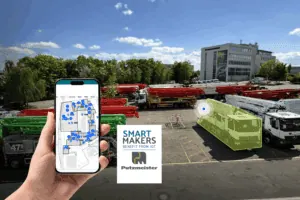Strategies for success: IoT in warehouse management - the best solutions
This article is dedicated to one of the most groundbreaking trends in modern warehouse management: the implementation of IoT technologies. Our ambition is to present you with a comprehensive guide that highlights the best solutions and strategic approaches to seamlessly integrate IoT into warehouse management. We explain in detail how these technologies can help optimize warehouse operations and increase efficiency.

Introduction
The term Internet of Things (or IoT) describes the networking of physical objects with the internet, allowing data to be collected and exchanged. This technology has taken on a transformative role in warehouse management. With the help of sensors, devices and systems, warehouse processes can be seamlessly monitored and controlled, ultimately leading to greater transparency and efficiency. Numerous processes can also be automated.
The evolution of warehouse management through IoT ranges from simple improvements such as real-time inventory management to complex applications such as vehicle coordination and predictive maintenance. This has not only revolutionized the way modern warehouses are run, but also opens up new possibilities for data-driven decision making in businesses. In the following sections, we will give you an insight into this fascinating development and shed light on how IoT is redefining warehouse management.
Integration of IoT into warehouse operations
The integration of IoT into ongoing warehouse management is a multi-layered process that begins with the careful selection and implementation of IoT devices suitable for your company. These include various sensors, IoT-enabled warehouse devices and data analysis tools. These devices need to be strategically positioned in the warehouse to capture and transmit data in real time. The next step is to seamlessly integrate these technologies into existing warehouse management systems, enabling seamless communication and data analysis.
Key benefits of IoT solutions for warehouse management
IoT-Warehouse management solutions have three main advantages:
- Efficiency
- Accuracy
- Real-time tracking
We take a closer look at all three areas below.
IoT for warehouse management is efficient
One of the outstanding advantages of IoT in warehouse management is its extraordinary efficiency. The automation of numerous manual processes by IoT devices leads to considerable time savings. For example, sensors automatically detect changes in stock levels, while IoT-enabled forklift trucks or drones optimize movements in the warehouse. This automation reduces the need for manual intervention, allowing employees to focus more of their attention on strategic tasks. In addition, the networking of devices ensures improved coordination and planning, which minimizes idle time and leads to more efficient use of warehouse space.

A IoT-based warehouse management system increases accuracy
The precision of a warehouse management system is significantly increased through the use of IoT . Sensors provide accurate information about stock levels and their condition. This data is crucial to minimize inventory errors and ensure more accurate order processing. Accurate inventory management plays a crucial role in avoiding overstocking or stock-outs, which in turn helps to reduce costs and increase customer satisfaction.
Real-time tracking
Real-time tracking is another significant advantage of IoT in warehouse management. The use of sensors and tracking systems enables continuous monitoring of stock levels and stock movements. This real-time data is essential in order to be able to react promptly to changes in demand or supply bottlenecks. It also enables more precise planning and forecasting, which is particularly relevant in dynamic industries such as e-commerce. In addition, real-time tracking supports safety in the warehouse by monitoring critical parameters such as humidity or temperature, which is extremely important for particularly sensitive products.
Best practices for IoT-based warehouse management
To realize the full potential of IoT-based warehouse management, companies can rely on best practices. These not only ensure efficient implementation, but also help to benefit from the advantages of IoT in the long term.
Integration of IoT into existing systems
One of the most significant challenges when implementing IoT technologies is the integration with existing warehouse management systems. To ensure seamless integration, it is advisable for companies to take a step-by-step approach. IoT-Solutions should be carefully selected and customized to ensure compatibility with the current system. This includes selecting IoT platforms that can interact with existing database systems and installed application software. Effective integration enables your company to easily collect and analyze data from IoT devices. The insights gained can in turn be used to optimize decision-making processes.
Optimization of inventory management
Optimizing inventory management is another key aspect of implementing IoT technologies in your company. By using IoT technologies with sensors, automatic inventory recording and tracking can be realized. These devices enable precise and timely monitoring of stock levels. As a result, you can expect a significant reduction in out-of-stocks or overstocks. Companies should also use data-driven analytics to understand inventory patterns and better forecast demand. This leads to more efficient reordering and helps to reduce inventory costs.
Improving safety and security
IoT can also be used to improve the safety and security of the warehouse. Surveillance cameras and sensors are used to monitor and detect unusual activity in the warehouse. Temperature and humidity sensors play a crucial role in controlling storage conditions, especially when handling sensitive or perishable goods. Real-time monitoring by IoT devices also enables an immediate response to potential security risks or emergencies. A well thought-out security strategy based on IoT technologies helps to protect your company's assets while ensuring a safe working environment for employees.
Conclusion on warehouse management with IoT
The development of IoT is progressing rapidly and new innovations have the potential to fundamentally change warehouse management as we know it today. Some of the most fascinating future advances will be enabled by AI algorithms that analyze IoT data and help companies manage their warehouses even more effectively. In addition, the combination of autonomous vehicles and robotics in warehouses, paired with IoT devices, will further increase efficiency.
In order to exploit the full potential of warehouse management with IoT , it is crucial to take all the aspects mentioned into account during strategic implementation.
The future of warehouse management will be significantly shaped by innovations in the IoT area. Companies that invest in this technology now will not only increase their efficiency, but will also be ideally equipped for the market requirements of the coming years. IoT is more than just a passing trend; it is an integral part of the evolution of modern warehousing. As a decision-maker, it is therefore of great importance to set the course for a forward-looking implementation in 2024.



